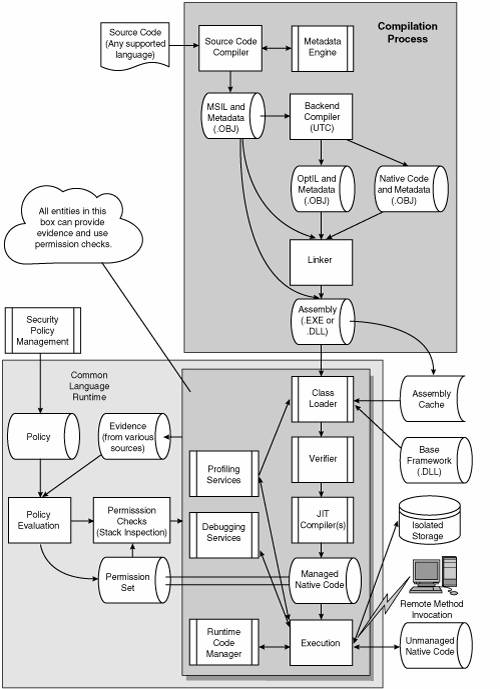The Necessity of a Forest-Level View
| A central activity in design-level risk analysis involves building up a consistent view of the target system at a reasonably high level. The idea is to see the forest and not get lost in the trees. The most appropriate level for this description is the typical whiteboard view of boxes and arrows describing the interaction of various critical components in a design. For one example, see the following box, .NET Security Model Overview. Commonly, not enough of the many people often involved in a software project can answer the basic question, "What does the software do?" All too often, software people play happily in the weeds, hacking away at various and sundry functions while ignoring the big picture. Maybe, if you're lucky, one person knows how all the moving parts work; or maybe nobody knows. A one-page overview, or "forest-level" view, makes it much easier for everyone involved in the project to understand what's going on. The actual form that this high-level description takes is unimportant. What is important is that an analyst can comprehend the big picture and use it as a jumping-off place for analysis. Some organizations like to use UML (the Unified Modeling Language) to describe their systems.[5] I believe UML is not very useful, mostly because I have seen it too often abused by the high priests of software obfuscation to hide their lack of clue. But UML may be useful for some. Other organizations might like a boxes-and-arrows picture of the sort described here. Formalists might insist on a formal model that can be passed into a theorem prover in a mathematical language like Z. Still others might resort to complex message-passing descriptionsa kind of model that is particularly useful in describing complex cryptosystems. In the end, the particular approach taken must result in a comprehensible high-level overview of the system that is as concise as possible.
The nature of software systems leads many developers and analysts to assume (incorrectly) that code-level description of software is sufficient for spotting design problems. Though this may occasionally be true, it does not generally hold. eXtreme Programming's claim that "the code is the design" represents one radical end of this approach. Because the XP guys all started out as Smalltalk programmers they may be a bit confused about whether the code is the design. A quick look at the results of the obfuscated C contest <http://www.ioccc.org> should disavow them of this belief.[6]
Without a whiteboard level of description, an architectural risk analysis is likely to overlook important risks related to flaws. Build a forest-level overview as the first thing you do in any architectural risk analysis.
One funny story about forest-level views is worth mentioning. I was once asked to do a security review of an online day-trading application that was extremely complex. The system involved live online attachments to the ATM network and to the stock exchange. Security was pretty important. We had trouble estimating the amount of work to be involved since there was no design specification to go on.[7] We flew down to Texas and got started anyway. Turns out that only one person in the entire hundred-person company knew how the system actually worked and what all the moving parts were. The biggest risk was obvious! If that one person were hit by a bus, the entire enterprise would grind to a spectacular halt. We spent most of the first week of the work interviewing the architect and creating both a forest-level view and more detailed documentation.
|
EAN: 2147483647
Pages: 154
